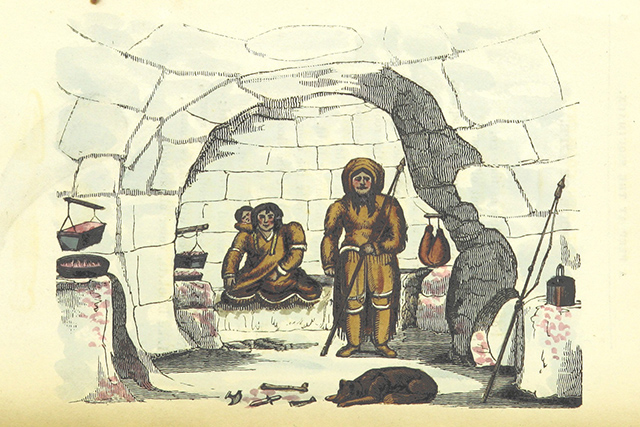Language and Artificial Intelligence
Linguist David Adger on the Facebook chatbots experiment, the history of getting the AI to understand and spea...

The Eskimo-Aleut family has two distantly related branches, Eskimo and Aleut, of which the former divides into the Inuit branch and the Yupik branch. The Yupik branch consists of five languages spoken mainly in Alaska and at the edge of Chukotka on the Russian side of the Bering Strait. The Inuit language is a continuum of dialects all the way across Northern Alaska and Canada to East Greenland, but there is minimal mutual understanding between the extremes of that continuum. Within Greenland, there are three dialects that are quite different from each other, and there is some problem with mutual understanding even there.
The number of people who speak these languages is estimated to be 85,000 altogether, of approximately 100,000 people who would call themselves either Inuit or Yupik. Forty-seven thousand of them speak the standard West Greenlandic dialect. Currently, there is a slight increase in the number of speakers of this dialect, which is very unusual for a polysynthetic language. The other dialects are pretty endangered. Twenty-four thousand are Canadian Inuktitut speakers, 2,000 Inuit speakers in Alaska, and 11,000 speakers of Yupik (only 300 speak it in Chukotka).

Everyone is in agreement that all the languages in this group derive from a common proto-language which must have been brought across from Siberia at some stage. It’s a little controversial exactly when and how that happened. There is ongoing research on this topic, especially on genetic and archeological factors, to help reconstruct the process.
The earliest sign of Eskimos around the Bering Strait was between 4,500-5,000 years ago. It’s disputed these days exactly which language they spoke, but my own conviction is that it was Proto-Eskimo-Aleut. There was some evidence of mixing of these newcomers from Siberia with people who already lived in Alaska 5,000 years ago, which begins to explain the fact that the very first Eskimos that showed up in Greenland are genetically not quite the same people as most Inuit from Canada, Alaska and Greenland. Something has happened in between. It’s a very complex history, but we know that the Inuit branch of the family formed in Northern Alaska only about a thousand years ago and spread rapidly across to Greenland. The first “Paleo-Eskimos” probably died out and were replaced entirely by the Inuit Eskimos, who may have mixed with other people of Alaska or Chukotka in the meantime.
The languages today have changed relatively little, at least structurally, and reconstructed Proto-Eskimo is very similar in structure to the modern dialects, although phonologically, there have been quite a lot of changes. There is particularly so as regards differences between the Yupik languages and the Inuit dialects. Even within the Inuit, there are considerable phonological differences. It should be mentioned that the phonological system of any of the dialects is relatively simple, but the morphophonemics, i.e., the way the individual units of meaning, morphemes, change according to their position in the word, is very complex, especially in the Yupik languages. The major difference between them and the Inuit language continuum is that Yupik languages have rhythmic stress that produces major changes in the shape of words. They have a kind of “stress-timed” system, whereas, in Inuit, it’s more “syllable-timed”, with more or less equal stress on successive syllables.
In Inuit, there are essentially three vowels, whereas Yupik has four. Consonant clusters are relatively simple, especially in Inuit, but are more complex in Yupik. The number of consonants does not exceed 20. Yupik has developed the most in phonological respects. Any of the Yupik languages compared to any of the Inuit dialects presents the maximum difference. There is not much difference phonologically between the different Yupik languages or between the Canadian Inuit dialects; it’s all relative. But within Greenland, there is a good deal of phonological difference between East and West Greenland, mainly due to isolation since there is an enormous distance between settlements. This relative isolation is true of all forms of Eskimo: there has been very little input from contact with other languages until recent times, especially in the case of Inuit. The dialects of Proto-Eskimo developed further and further in terms of their phonological and morphological elaboration without being influenced by neighboring languages.

All Eskimo languages are polysynthetic; that is, the meaning of utterances is constructed by combining many different morphemes in a single word. The Eskimo type of polysynthesis is the suffixing-only type, which is rather rare. Unlike more typical polysynthetic languages, which display noun incorporation (adding a noun within a verb to change its meaning), it does not have that feature at all. Each word consists of a single lexical stem and many affixes following it so that the meaning of a whole sentence can be contained in one word. It also has a recursive kind of morphology, meaning that there can be several switches back and forth between nominal and verbal within a single word, which is, again, quite unusual. Some of the affixes are lexically heavy; that is, they greatly affect the overall meaning of the word. They are “bound lexical affixes” whose meanings are similar to those of verbs, nouns, or adjectives in English. Here is an example of how you build up a complex word sentence from West Greenlandic:
Nannu-n-niuti-kkuminar-to-rujussu-u-voq
Polar.bear-catch-instrument.for.achieving-something. good.for-PART-big-be-3s.INDIC
The stem means “polar bear,” and then there is an affix which means “to catch,” followed by affix -niuti-, meaning “instrument for achieving something”, then another affix which means “be good for/at something,” and then all of that is turned into a nominal by a participial affix. Note that affixes are either nominal or verbal in their own right and can convert the stem from noun to verb or verb to noun several times in one “word sentence”. There is no indication of plurality – plurality is only indicated in the inflection. The next affix -rujussu- corresponds to “big,” and the following affix -u- is “be”. The inflection -voq indicates “3rd person singular subject, indicative mood”. This is something (along with the unitary intonational “shape” of the word) that makes it quite clear that we are dealing with a single word here: the lexical stem must appear at the start of the sentence, and the inflectional affix at the end.
One of the things special about Eskimo morphology is that it has an intermediate category between derivational affixes (which change the meaning of the word) and inflectional ones (which indicate the grammatical function of the word). These “sentential affixes” occur just before the inflectional affix at the end. Like derivational affixes, they are not obligatory, but they indicate tense and modality and a few other things that apply to the whole sentence. These sentential affixes have to occur in a certain order, and then they have to be followed immediately by the inflection, which is the only element besides the stem that is obligatory. The order in which these elements occur is then: stem > derivational affixes > sentential affixes > inflection.
Eskimo languages are structurally very regular. The semantics, the way you build up a complex meaning from its morphological components, is very transparent; you just add successive affixes in a logical order so that each affix takes everything before it in its scope. So a word is gradually built up in a logical fashion until the final closing point, the inflection, is added. There is no irregularity in that sense. Irregularity is confined to the morphophonemics, the way you attach affixes to those preceding them, which is especially complex in Yupik languages.
I should mention here two other unusual things about Eskimo languages. They are ergative, i.e., the subject of intransitive sentences and the object of transitive ones are marked the same way. Moreover, they display case endings on nouns, both grammatical (like “transitive subject”) and spatial (like locative or ablative). Not many polysynthetic languages are ergative like Eskimo or display a full array of nominal case endings. That ergativity has developed in Eskimo is due to historical reasons: the transitive clause in these languages is built up from a possessed nominal construction. Thus the historical source of a sentence like “He killed a (wild) reindeer” is something like “His killed thing was a reindeer”.
In Eskimo, like in most polysynthetic languages, one often has a choice either to express a sentence as one word or to split it up into several. For example, you can either say, “He caught sight of a reindeer” as a single word: tuttu-si-voq (reindeer-get-3s.INDIC), or as two words, where “reindeer” is a separate object noun: tuttu taku-aa (reindeer see-3s/3s.INDIC), “he caught sight of the reindeer”. If you chose the second option, you are using the meaning of “reindeer” generically, about an indefinite “reindeer”, whereas if you separate it as an independent nominal, it’s going to be a more definite, specific one.
The lexicon of Eskimo languages consists of stems and affixes. There is a restricted number of stems, and these are either nominal or verbal (nouns or verbs), and nothing else apart from them. A few uninfected particles but no adjectives or prepositions. Adjectives are usually expressed either as stative verbs (verbs expressing states) or as affixes, and prepositions as case endings or special “applicative” affixes on verbs.
A typical Eskimo dictionary is much like those we have for European languages; it lists nouns and verbs alphabetically. But what is special is that a large part of the dictionary must be devoted to affixes. In any Eskimo language, there are at least 400 derivational affixes by which you create a new word from an existing stem (e.g., run => runner or soft => soften) and at least 400 inflectional ones (many more in Western dialects) by which you create different inflected word forms (e.g., run => runs).
How do you decide whether a certain combination is lexicalized? Take a West Greenlandic word like Ilin-niar-tit-si-soq (learn-try.to-cause-INTR-PART, where ‘“INTR” is an intransitivizing affix and “PART” is a participial-forming affix), which means “teacher”. It consists of four different affixes added to the stem “learn”, and in this case, it will certainly be entered in the dictionary as a unit. And what do you do with verbs? The conventions can vary, but in any dictionary, you will need to include the verbal stem ilit- “learn” but also ilinniar- “study” and ilinniartit- ‘“teach” as separate entries (whether or not you add a suitable inflection). This is a matter of the obvious usefulness of these concepts in daily usage.
There is a widespread misconception that Eskimo languages have a huge number of words for “snow”. There are, in fact, only about 4 or 5 stems, which uniquely mean “snow”: snow on the ground, snow in the air, blizzard, etc. But there are also many extensions derived by attaching affixes to simple stems. The same applies to words for ice. More esoteric items, like Greenlandic tuaq meaning “new ice formed in the crack in old ice,” will still be known by hunters in the hunting districts but not so much by younger speakers in the towns.
Perhaps more notable is a large number of demonstrative stems in these languages, especially in Alaska. Central Alaskan Yupik, for example, has 29 distinct stems corresponding to “this” and “that” in English. The dimensions involved include “up there” as opposed to “down there” and “in there” as opposed to “out there”, all in “restricted”, “extended,” or “obscured” variants.
As regards color terms, there is a fair range of them, but it is noteworthy that only black and white are expressed by opaque terms, whereas for all the other words like “green” and “red,” the source of their meaning is transparent. Thus “red” is aappalaartoq in West Greenlandic, literally “resembling blood” – the stem aak is “blood”, here becoming aap- before the affix -palaartoq “resembling”.
There are of course some concepts (especially concerning technological innovations) that Eskimo languages do not have special words for, as with all languages. But you can always express the meaning in any language (say English) by an explanatory phrase or the extension of a basic word or by using an old word in a new sense. For instance, “computer”. In West Greenlandic is qarasaasiaq, which can be analyzed as a “thing made like a brain” (qarasaq “brain” + -asiaq “thing made like”). A typical neologism, of course.

How children acquire an Eskimo language is a very interesting question and relatively little had been done about it until recently. It is an area I have investigated myself. Children learning English go through a one-word stage (in which they communicate using single words), then a two-word stage (where they combine two different words), etc. Eskimo children do not go through a two-word stage; they rather go through a two-morpheme stage, a stage where they mostly combine a stem with a single affix. They extend this by adding different affixes to the lexical stems that they already know (ones that they learn early, especially nouns).
The interesting thing is that they usually start with inflectional affixes on stems and then begin experimenting with derivational ones, putting them in between the stem and the obligatory inflectional ending. In other words, they are building up more complex words “from inside”, which is rather unusual. Then they go further and experiment with inserting a second derivational affix, adding to forms they already know. They will end up with adult-like word sentences. The process is perhaps not so different from that of children learning European languages, except that the mean length of utterances must be measured in morphemes, not in words.
There are other aspects of these languages that one would imagine would make them difficult to learn. But if you think about it, what English or Russian children face is not that different: they also hear sentences that consist of words that are not necessarily chopped up clearly, word by word. Eskimo children have to break up the morphemes within complex words, and that makes it a bit more difficult because of the morphophonemic changes I mentioned earlier. This is difficult for them to get around, but by listening carefully, they learn that affixes have different shapes depending on what you add them to. They do over-generalize sometimes. For instance, they may use the same affix everywhere, whereas, in fact, you have to change it according to the context. But, as I said, it is usually recognizable and semantically transparent in any form. Also, there are no irregular paradigms of inflections for individual stems.
What a child has to learn is how to construct word sentences out of a stem with the help of numerous (derivational) affixes. These are not organized by fixed slots since if you change their order, you probably change the meaning, unlike in a purely templatic kind of polysynthetic language. As I have explained, you build up a word sentence recursively based on logical scope until the inflectional ending is reached.
What is easier to learn for Greenlandic children is syntax. This is very simple in Eskimo languages because so much syntactic information is expressed morphologically. The word order is relatively free, so there are no particular difficulties there.
Although many studies of Eskimo languages within specific theoretical frameworks have been carried out, there are many aspects of them which still have not been studied in detail, especially outside of Greenland. Also, within Greenlandic itself, there are elements of the language that need further investigation. For example, the derivational affixes that cover “aspectual” meanings (phase or extension in time), are in abundance in any Eskimo language. There are dozens of them in any one dialect, and their exact meanings and many possible combinations need to be studied.
There are further studies being conducted as to how Inuit languages are acquired by children, mainly on Canadian Inuktitut. On the other hand, next to nothing has been done on how children learn Yupik, which urgently needs to be done while those languages are still viable.
One general area of study which I am involved in myself is investigating the origin of the Eskimo-Aleut language family in Siberia and how it is related to other languages there, Uralic ones in particular. It is a controversial area but one that has been discussed for many decades. I have been looking at the ways in which a Uralic kind of language could have developed into an Eskimo one. Even though this must have happened many thousands of years ago, and the common ancestral language – if it existed as a unified entity – can probably not be reconstructed in any great detail, the inflectional system can, to a large extent, be compared with that of especially the Samoyedic branch of Uralic. The problem is that the relationship is so distant that there are relatively few lexical stems that can be reconstructed for the hypothetical proto-language. We know at least that Eskimo languages came into North America much later than Indian languages and that there has been much contact between Siberian Yupik and neighboring Chukchi in recent centuries. Population genetics is beginning to cast fresh light on these matters.
Another matter is what happens when a highly polysynthetic language like Eskimo becomes less synthetic or gradually dies out under the influence of colonial languages like English and Russian. Most polysynthetic languages are already highly endangered, and some are becoming less synthetic in the process, which is what has happened within Eskimo-Aleut most clearly with Aleut. This is not yet evident in eastern Canadian Inuktitut or Greenlandic, but in the West, we can see signs of Eskimo languages becoming less synthetic as they are gradually lost, replaced by English or Russian. Even West Greenlandic has simplified its inflectional apparatus; the dual number found further west disappeared almost entirely some time ago. However, this is one of the first distinctions you might expect to undergo simplification and is unlikely to be due to Danish influence on the language (which is restricted to lexical items).

One last matter worth mentioning is the question as to whether the way languages develop has something to do with the way of life of its speakers. There are certain conditions where it is more likely than others that polysynthetic languages should develop, notably among hunter-gatherers. Although not all hunter-gatherers speak such languages, it is true that it is mainly among small isolated groups of people who do not have many neighbors to communicate with that languages tend to get more and more complex, especially in their morphology. That is, until there is some reason to stop the process, and the reason to stop is usually contact with other languages. Until recent meetings with speakers of English, Russian, and Danish, Arctic hunter-gatherers did not have much contact with other languages, and the result of such contact in recent times has resulted in some places simplification and even in the appearance of short-lived Eskimo-based “pidgins” or trade jargons.
Nevertheless, the prognosis for the survival of at least some forms of Eskimo into the next century – especially West Greenlandic and eastern Canadian Inuktitut – is rosier than for most of the world’s other polysynthetic languages. There is certainly awareness among speakers in Greenland and in Nunavut and Nunavik in Canada, regions already enjoying some form of Home Rule, of the cultural importance of maintaining their languages for future generations.
Side note: On the use of the term ‘Eskimo’
There is a problem with the word ‘Eskimo’, especially for the linguist. People in Canada much prefer the word ‘Inuit’ of course (which just means ‘people’), but this does not include the other branch of the family, Yupik, in southwest Alaska and on the Russian side of the Bering Strait, so is rather insulting to those people when others use the term ‘Inuit’ about them. It is mainly in Canada that the word Eskimo has become more or less taboo. This is because people think it comes from an Algonquian word for ‘raw meat eaters’. This is debatable. In fact there is an equally – if not more – plausible source in the most adjacent Algonquian dialect that just seems to mean ‘speaker of a foreign language’. The Inuit of North Alaska (the ‘Inupiat’) are less fussy, and in Greenland, the word ‘Eskimo’ has largely historical connotations, the word ‘Kalaallit’ being used by the people about themselves.
Of course, when referring to the people, one should respect local (well, Canadian!) usage, and anthropologists generally do. But for linguists, there is no real alternative to using the term ‘Eskimo-Aleut’ to refer to the language family as a whole (and to ‘Eskimo’ as the major branch comprising Inuit and Yupik).

Linguist David Adger on the Facebook chatbots experiment, the history of getting the AI to understand and spea...

David Dussault on human relationships, life experience and how to understand the influence that IT has on our ...

Communication scholar Grant Kien on relational materiality, messy networks, and power as a social phenomenon